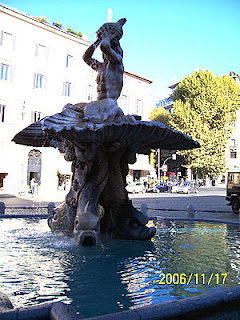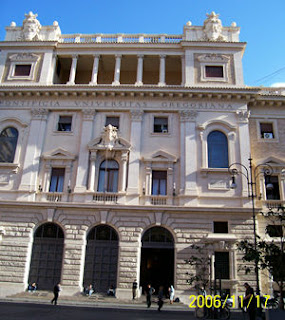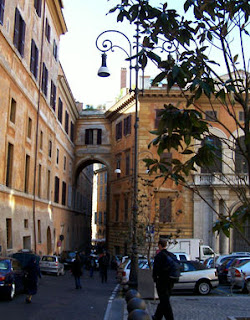On Friday 17th and Saturday 18th November during the mornings we explored Rome on foot, seeking out interesting architecture, monuments and fountains. Walking everywhere was good to counteract the deleterious effect of pasta and pizza on the waistline.

This first photo is of Via Nazionale just down the road from our hotel. The very interesting church on the right-hand side is the church of San Paulo Entro da Mura, or in English, Saint Pauls within the Walls. The reference to walls is of course the old Roman walls that surrounded ancient Rome. Only small bits and pieces of the old walls remain today, but more about that later. The church steeple has an interesting array of bells which produce an awesome sound.

One of the most famous fountains of Rome is Bernini's baroque Triton Fountain (Italian: Fontana del Tritone) erected in 1643, on the Piazza Barberini.
In the fountain an over-lifesize muscular Triton, a minor sea god of ancient Greco-Roman legend, is depicted as a merman kneeling on an opened scallop shell. He throws back his head to raise a conch to his lips. From it a jet of water spurts, formerly rising dramatically higher than it does today. The fountain has a base of four dolphins that entwine the papal tiara with crossed keys and the heraldic Barberini bees in their scaly tails. The Tritone, first of Bernini's fountains, was erected to provide water from the Acqua Felice aqueduct.

Another equally famous fountain is the Trevi. The Trevi Fountain (Italian: Fontana di Trevi) is the largest, standing 25.9 meters high and 19.8 meters wide, the most ambitious of the Baroque fountains of Rome.

The fountain at the juncture of three roads (tre vie) marks the terminal point of the Aqua Virgo (Italian: Acqua Vergine), one of the ancient aqueducts that supplied water to Rome. In 19 BC, supposedly with the help of a virgin, Roman technicians located a source of pure water some 13 km from the city. This scene is presented on the present fountain's facade. However, the eventual indirect route of the aqueduct made its length some 22 km.

The Piazza de la Pilotta is surrounded by several interesting-looking buildings, one of which is the Pontifical Gregorian University (Italian: Pontificia Universitas Gregoriana), which is a Roman Catholic university in Rome. One of the oldest in the world, the university celebrated its 450th anniversary in 2001. Its principal purpose is to assist in the education of young men for the Catholic priesthood and to train clerics and laity in advanced sacred disciplines. It has one of the largest theology departments in the world, with over 1600 student-priests, seminarians and religious from over 130 countries.

Something else we found rather amazing is the narrowness of some of the streets. Just have a look at Via del Faccaro (to the left of the Piazza de la Pilotta in this photograph), followed by another narrow alley we encountered somewhere else in Rome.

There is room for only one vehicle at a time and the road curves, so you can't see what's coming from the other side. No, it is not a one-way street!

No comments:
Post a Comment